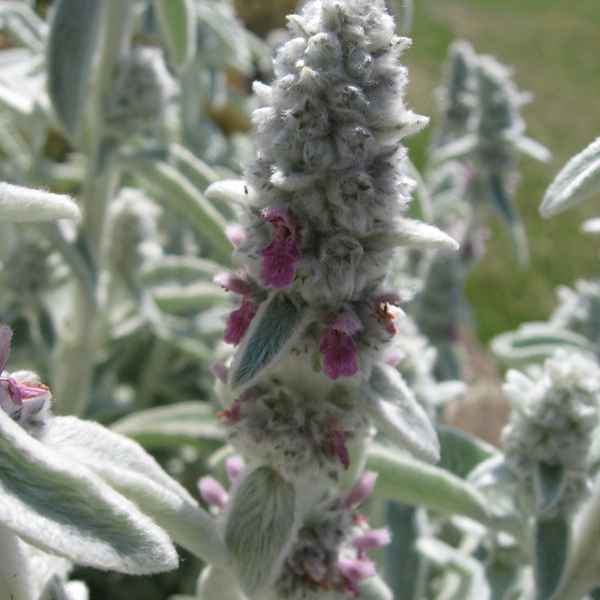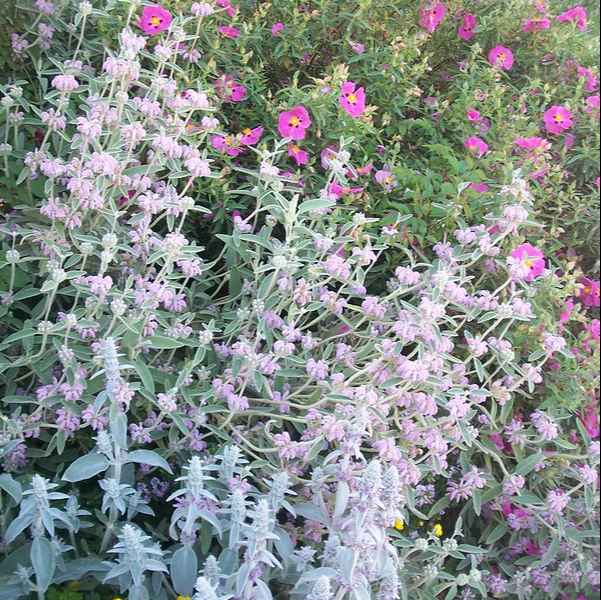Stachys Lanata
Stachys Lanata
Lamb's Ear
Couldn't load pickup availability
Sustainably Grown Organic Stachy Lanata (Syn. byzantina)
If you're a fan of soft, velvety foliage, then this is the plant for you! this organic Stachys lanata (or Stachys byzantina), commonly known as Lamb's Ears, is a herbaceous perennial with lovely soft foliage that brings other benefits to your gardens ecosystem
🐑 Foliage
The star attraction here is undoubtedly the leaves. Densely coated in soft, silvery-white hairs, they have an alluring fuzzy texture that simply begs to be touched. These woolly wonders form a neat, spreading mound, reaching just 8-12 inches in height but often sprawling up to 18 inches wide.
While the foliage is the main event, Lamb's Ears does produce dainty purple-pink flower spikes in early summer. Admittedly not the showiest of blooms, but they make a lovely contrast against the silvery leaves and attract plenty of beneficial insects.
🐝 A Magnet for Beneficial Insects
Lamb's Ears is an insects dream - Those spiky blooms are rich in nectar, luring in bees, but also hoverflies and other useful insects that help keep your garden in balance and pests in check. Plus, the dense foliage provides perfect nesting spots for many species of solitary bees.
☀️ Climate Resilient
With our weather becoming ever more unpredictable thanks to climate change, we need tough plants that can roll with the punches. Stachys lanata fits the bill perfectly! It's exceptionally drought-tolerant and able to withstand periods of intense heat and dry spells with ease. But it's no slouch when it comes to coping with cooler, wetter conditions either. This resilient little plant will just keep on going, no matter what the weather throws at it. Indeed, Matthew Pottage from the RHS recommended this on GQT as the perfect plant for climate change!
🌿 Habit
It's drought-tolerant once established, and even flourishes in poor, dry soils – making it ideal for those sun-baked spots where little else will grow. While it prefers full sun, it can handle a bit of afternoon shade too.
This tough little number will bring that quintessential cottage garden charm wherever you plant it. Use it as a delightful edging along borders, let it tumble over rockeries, or even allow it to soften the crevices between paving stones.
🌸 Planting Partners
Given its low, sprawling habit, Lamb's Ears works beautifully as a foil for taller, more vertical plants. Try pairing it with:
- Ornamental grasses: The soft textures of the Lamb's Ears will offset the tall, arching stems of grasses like fountain grass.
- Lavender: A classic combination! The silver foliage complements the purple blooms of lavender perfectly.
- Sedum: For a gorgeous autumnal spectacle, let Lamb's Ears merge with the plump, ruby-red flower heads of 'Autumn Joy' sedum.
- Alliums: The big, bold pom-pom flowers of ornamental onions look simply divine emerging from a sea of woolly leaves.
🌱 Growing Tips
Lamb's Ears is ridiculously easy to grow. Plant it in well-drained soil in full sun to partial shade. Once established, it's highly drought tolerant, needing only an occasional drink during exceptionally dry spells.
Trim off any tatty leaves in spring, and enjoy fresh new growth emerging shortly after. In milder areas, you can leave the foliage over winter for added texture and protection.
While the plant self-seeds readily, the resulting seedlings are generally true to the parents. So embrace the occasional newcomer, or simply remove them if you prefer to keep things tidy.
One word of caution – the dense woolly leaves can trap moisture, leading to fungal issues in very humid areas. If this is a problem, trim off any affected foliage promptly.
So there you have it – a low-fuss, high-impact plant with irresistibly fuzzy foliage and a pollinator-friendly nature. With its resilience and ability to cope with our changeable climate, Lamb's Ears is a brilliant addition to any garden for years of woolly wonder!
Plant care guide
Plant care guide
How do you plant perennials?
Dig a hole slightly larger than the woodfibre pot or balled rootball size, but no deeper. If it is a plant that likes to stay on the drier side (such as lavender), make the hole slightly shallower than the root ball so the surface of the rootball sits proud of the ground and use organic matter around the plant to stop water pooling on the base of the plant.
Water the hole and if the woodfibre pot or rootball doesn't seem moist pre-soak the pot or hessian contained rootball until it is saturated (no more bubbles rise to the surface).
There is normally no need to add compost to the hole if you have an established garden with healthy plants already growing. If you have a newbuild property or poor growth to existing plans chances are that your whole flowerbed needs improving with organic matter.
Place the pot or rootball in the hole. You can remove the hessian sacking it came in, or just remove the staple/twine and open the top once it's in the ground so the plant is free. The roots will easily grow through and the hessian will decompose, as will the woodfibre pots. Back fill the surrounding area with the dug soil. Do not firm the soil down hard! Roots need air and water and hard compacted soil prevents them from getting both.
Once planted water the plant in well and then water again whenever the soil starts to dry out under the surface, being careful not to overwater.
Mulching with something like woodchips around the plant after watering will help the soil to retain the moisture in hot weather. The perennial's foliage will die off in the winter and the plant will regrow through the mulch in the spring!
When to plant perennials in the UK?
Perennial plants can be planted out in the garden or in pots from spring, through the summer, to autumn. During dry weather and especially during the summer much closer attention needs to be given to watering in the first year.
If planting in hot weather, cut the foliage and flowers back. Your new plant will not be taking up much water until established so may struggle if the leaves lose more water than the roots can absorb. For the strongest result do not allow to flower or at least to set seed in the first year.
Where to plant perennials?
Check the plant info at the bottom of the page for the best place to position your new plant. If it prefers sun and you plant it in a north facing flowerbed next to a wall don't expect it to thrive or flower.
Pay attention to the soil. if it is heavy clay, incorporate organic matter such as compost to the soil before planting your perennial, preferably to the whole flowerbed. This will improve the soil by buffering it's water and nutrient holding ability. It is preferable to not just plonk compost in the bottom of the hole as it will not improve the overall condition of the soil surrounding your new plant. Do not add a layer of gravel or grit to the bottom of the hole as this will merely cause the perched water table to be higher. It will not improve drainage.
How do you care for perennial plants?
Cut back untidy foliage in the spring (you can leave the clippings on the flower bed to allow the nutrients to recycle into the soil). Divide every 3 to 5 years as the centre dies out and replant your extra plants! Perennials come back every year. Some are longer living than others.
Should perennials be fertilised?
The vast majority of garden soils contain plenty of nutrients, but if your garden is in a newly built development there is a good chance a thin layer of topsoil has been added on top of infertile subsoil. if that is the case, compost, soil improver or well rotted manure can be spread on the flower bed and dug in, or alternatively for those short of time or energy, organic fertiliser such as our own special organic mix of bone meal, hoof and horn and vinaase that is an organic, sustainable alternative to the John Innes formula, can be sprinkled around the plant with some compost added to the planting hole.
Delivery £5 flat rate or FREE over £50 spend.
Delivery £5 flat rate or FREE over £50 spend.
I charge a flat rate of £5 for postage and packaging to all of Britain, including the Highlands and the Isle of Man, with free delivery for orders over £50. We are unable to send plants to Northern Ireland.
I use Royal Mail for our deliveries as they have the lowest carbon footprint per parcel delivered in the UK and actually tend to look after parcels rather than just chucking them over the nearest fence! This ensures that your plants will have the best care possible.
Please have a Safe Place set up if possible so your plants are not returned to the sorting office if no one is home to accept the delivery.
I try to dispatch plants twice a week and you will receive updates by text or email. In cases of extreme weather or if Royal Mail has a hiccup the delivery may be delayed but we'll keep you in the loop.
I'm unable to deliver to the Channel Islands or Northern Ireland.
The LAWNMOWER Guarantee
The LAWNMOWER Guarantee
Healthy plants & happy customers
Your plant will only be dispatched if I'm happy it is healthy. The nature of growing the plants in large troughs means that the root system will be trimmed before they are balled in hessian, and therefore, depending on the time of year, the top growth may also be trimmed to make sure the roots are able to supply the water and nutrients your new plant requires.
Pruning encourages new growth and this applies to roots as well so a pruned plant actually results in a stronger plant.
The LAWNMOWER guarantee.
If you're not happy with your plants for any reason, even if you've run them over with your lawnmower, just pop them in a box (the plants, not the mower!) and post them back to us within 1 year for a replacement or refund.
This does not affect your statutory rights.
For full details check out the Refunds and Returns Policy.
Sustainability
Sustainability
Eco-friendly business
Fed up with plants grown in plastic pots which are doused in herbicides and sprayed with synthetic chemicals by big nurseries who merrily burn through finite resources, fly plants in from abroad on jet planes, irresponsibly use peat and coir, kill any insect nearby with non-selective pesticides and generally only think of the bottom line?
So are we!
How we grow plants sustainably
Our plants are started in coldframes or inside our house, grown-on woodfibre pots or in reclaimed wooden troughs which are then carefully harvested and balled and burlapped (hessian wrap securing the rootball), before packing plastic free in a eco cardboard box from a certified B-corp carbon neutral supplier. Some plants are grown in 8cm woodfibre pots.
Sustainable and organic compost & fertiliser
Our Soil Association certified organic compost is bought in bulk without plastic bags from Dalefoot Compost, and consists of sheep wool, bracken and comfrey. This naturally feeds the plants for 12 months. If supplemental feeding is required we only use our own special blend of organic fertilisers (bone meal, hoof & horn and vinaase) which have been processed with solar energy.
Carbon Neutral business
The small amount of electricity we use is from renewable sources and we irrigate our plants with stored water we have harvested. Plus, we are using our house and land for more than one purpose, preventing further land use and utilising the sunk carbon cost of the building rather than creating more.
We have partnered with Carbon Neutral Britain to offset our emissions, and recognise that we are not in control of all parts of the supply chain so have fully offset scopes 1, 2 and 3 to take that in to account - so that's all emissions connected to our business, from the farts coming out of the back of the sheep, to the carbon dioxide from the delivery van outside your door.
We don't just offset and carry on, ALL the decisions we make work to reduce emissions - for instance we use Royal Mail to post our plants as they have by far the lowest carbon footprint per parcel delivered in the UK.
Stachys Lanata




